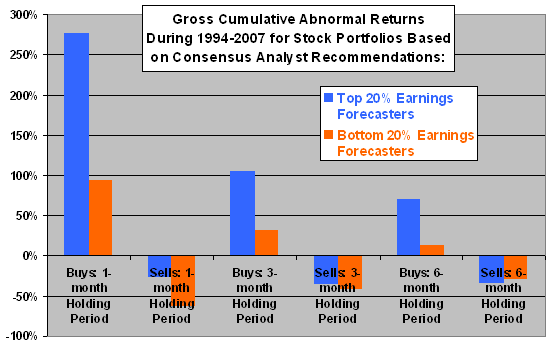Are some analysts better stock pickers than others? How can investors discriminate? In their May 2010 paper entitled “Projected Earnings Accuracy and the Profitability of Stock Recommendations”, Daniel Kreutzmann and Oliver Pucker employ a three-step process to determine whether investors can use analyst characteristics to identify superior stock recommendations in real time: (1) relate eight analyst characteristics to past analyst accuracy in forecasting firm earnings; (2) apply these relationships to project individual analyst future earnings forecast accuracy; and, (3) relate the returns of consensus stock recommendations over holding periods of one, three and six months for the fifths of analysts with the highest and lowest projected earnings forecast accuracies. Using monthly analyst characteristics, earnings forecasts and stock recommendations, along with actual firm earnings and returns for recommended stocks, spanning 1994 through 2007 (168 months), they find that:
- The fifth of analysts with the highest projected earnings forecast accuracies: have high prior earnings forecasting accuracy; make frequent earnings forecasts; revise earnings forecasts frequently; and, cover few companies and industries.
- There is a statistically significant difference in realized earnings forecast accuracies between the top and bottom 20% of projected accuracy, but the economic difference (based on a discounted earnings calculation) is not material.
- A portfolio that is long the consensus “Buy” recommendations of analysts in the top 20% of projected earnings forecast accuracy, reformed monthly, generates an average gross annualized abnormal return of about 7.5% during 1994-2007 (see the chart below). Trading frictions would debit this outperformance.
- Results are generally robust to substitution of change in consensus recommendation for consensus recommendation (with average gross annualized abnormal return about 6.3%).
- Results suggest that the value of stock recommendations may lie in analyst considerations beyond discounted earnings models and/or that analysts with high projected earnings forecast accuracy better assess firm specific risks.
The following chart, constructed from data in the paper, shows the gross cumulative abnormal returns (adjusted for market, size, book-to-market and momentum) during 1994-2007 for monthly sorts of analyst stock recommendations according to: (1) whether the recommending analyst is in the top or bottom 20% of all analysts with respect to projected earnings forecast accuracy; (2) whether the consensus recommendation for a stock within the top or bottom forecasting group is “Buy” (< 2 on a scale of 1 to 5) or “Sell” (> 2.5); and, (3) holding periods of one, three and six months.
Results indicate exceptional outperformance for a portfolio long the recommendations of the group of analysts with the highest projected earnings forecast accuracy, reformed monthly and held for one month. There would be a trade-off between holding period and cumulative trading frictions.

In summary, evidence indicates that expert analysts who have relatively high prior earnings forecasting accuracies, forecast frequencies and forecast revision frequencies and who cover relatively few companies and industries make abnormally good stock recommendations.
Testing of many rules/combinations in this study suggest that data snooping bias may induce material overstatement of return expectations.